By Jamey Ellis
Each of us has given without the expectation of receiving. Each of us knows the rewards of doing so. Sometimes the joy felt by those giving can even seem to outweigh that of the ones receiving.
We’ve all taken part in a gift exchange, be it birthdays, holidays or anniversaries. But do we actually need to wait until a specific moment to find that joy of giving? Could such giving, or sharing of resources, be applicable in our daily lives and on a large scale? What would happen if each of us gave away some of what we had in surplus – be it our skills, time, resources, or finances -- on a daily basis? How about a gift economy?
Gift economies already exist. I know because I live and work in one. Though it is yet to be embraced on a government level the concept has taken root around the world. The booming growth in volunteering exists around the globe. The actions taken by citizens in the U.S. after both Hurricanes Katrina and Sandy stand in testament to this concept. The U.S. government largely failed us during these emergencies, while our neighbors and even strangers provided both immediate care and rescue as well as long term help.
Let me make a disclosure before we go further and before someone begins penning a retort that I have no interest debating here. I am not an economist or an expert on gift economy (or any other type of economy, for that matter). I’m an individual who has lived very comfortably by practicing gift economy, full time, for the last five and a half years. I was asked to share my experience and do so happily. Please take what you will from my experience.
Over six years ago, I left a nice home and satisfying work in New York City to begin bicycling around the world. Travel seeming inherently selfish from my perspective, I knew I wanted to give back while pursuing my dreams. Thus began my volunteering in the locations that I rode to. After six months of this, I peddled my way into the community that would become my home and current life’s work, Sadhana Forest.
At the time, Sadhana Forest consisted of a sole location in Tamil Nadu, India. It was at that time (and continues to be) a part of a larger community called Auroville, a 45+-year-old city founded on the principal of human unity. Over the last five years, Sadhana Forest has expanded to Haiti and Kenya.

A family of three, Aviram and Yorit Rozin and their eldest daughter Osher, founded Sadhana Forest India in 2003, in order to seek out their personal method of sadhana. Sadhana is a Sanskrit word that translates, more or less, to ‘one’s spiritual path’. Their chosen path was through indigenous reforestation of the native, endangered ecosystem that is called the Tropical Dry Evergreen Forest. They hoped others would join them in this selfless work and help prevent one more environmental tragedy from entering the history books.
When they were granted stewardship of the 70 acres of fully degraded land, nothing existed there. There weren’t two strong trees to hang a hammock between, let alone access to water or any form of shelter. Theirs was a personal commitment to transform that barren land through their own labor and perseverance. Imagine their surprise when a volunteer arrived on their fifth day of living on the land. He’d gotten word of the start of a new community and wanted to help. He had the time and willingness to support others that he didn’t know. Equally important, the Rozins had the openness and willingness to accept his gift.
Being open to receive help seems to be a challenge for many; particularly so when money is part of the offer.
Within that first month nearly 20 people would arrive with offers to help. Some stayed for a few weeks while others ended up staying for months on end. Because the Rozins never anticipated this undertaking would become a ‘volunteer community,’ they had not budgeted for one. Aviram and Yorit had moved onto the land with enough money to support their family for a year-and-a-half. But they suddenly found themselves surrounded by kind, generous people, and felt they wanted to show their appreciation for the unexpected support. They took their savings and began building a second toilet, a dormitory, and so on. In just four-and-a-half months, their savings were exhausted. It was with this first volunteer that they began practicing their gift economy. They embraced the risks of letting it become their only form of work, supported solely by this type of economy.
Before I go on, I would like to share a personal anecdote:
A few years ago I had just returned to the U.S. to apply for a new visa. I was riding a bus from the airport to my parents’ house. I chatted with a kind, older woman sitting next to me. She was interested in my work and very interested in how I supported myself financially, since I’d exhausted my personal savings by this time. I realized at that moment, and explained, that I am investing in human capital rather than monetary capital. It was the first time I’d ever verbalized this.
She didn’t quite get it, so to illustrate my point I explained how I could be like many Americans and invest in Wall Street. Because investing in anything is a gamble, like those who put their life savings into risky stocks, I saw myself standing to lose my investment -- be it for honest or all-too-often dishonest reasons. She nodded in quick agreement telling me how she and her husband had lost a lot during Enron’s collapse.
I went on to say that investing in human capital isn’t without risk, but experience has shown me that at the end of the day my neighbor is more likely to care for me than my bank. This was a woman who was old enough to remember the previous generations that understood how things like repairing rather than throwing away purchased items and investing more in their neighbors and neighborhoods helped foster sustainability.
Here are the dividends of such an investment: From one volunteer on Day 5, there are now roughly 1,000 per year, making this little family project one of the world’s largest residential volunteer projects. In addition, several thousand guests visit each year and Aviram and Yorit seek to make each of them feel as welcome as the first volunteer was. Whether the visitor is there for 15 minutes or 15 months, each is accepted as a member of the Sadhana Forest community and each may choose to make it her or his home as well.
Amazingly most of this growth has been through word of mouth. It has led to invitations to do the same work on all six habitable continents; to the establishment of two more communities on two different continents; and to a reported shift in many people’s lives to be more sustainable, more giving, more honest, and more aware that we can pursue alternative economies other than the prevailing capitalist economies of the world, fraught as they are with the objective of individual gain at the cost of the labor of others.
By welcoming their first volunteer, the Rozin family began to set a precedent of giving, but it wasn’t simply that act alone. They also choose to live a principled lifestyle centered on human unity, veganism, non-competition, sustainable living, and unschooling. They let seva (meaning selfless service in Sanskrit) lead their actions. They don’t ask to be paid for their knowledge in the belief that knowledge should be free. They apply critical thought to make choices that reflect peaceful practices and outcomes. These philosophies and practices are the resources that they have in abundance… so they share them.
Most of us love to be shared with. Want to split this last piece of cake with me? I just won the lottery, would you like half? Don’t you smile at the thought of either of those scenarios happening to you?
I can’t tell you how to manage a gift economy on a large scale. I can tell you that years of experience surrounding this topic have taught me at least one thing. If some of your goals are deemed of value and mutual interest, if you communicate them with those that want to know and if you work with integrity, then people are inclined to not only respect you and perhaps to be inspired by you but they may also support you.
We all know and practice gift economy, though we may not have put a title on it before. Now that you have a name for it, you may be more aware of when you give without expecting to receive. Being more aware may lead you to doing it more often. Giving more of yourself or what you have to share will probably lead to others to do the same. Who can argue with that?

The crises provoked by the COVID-19 pandemic have revealed for all what many have long known: the foundations of the wealth and well-being of the world rest upon the sphere of social reproduction and the labor of care. This work is performed primarily by women and, more generally, by people whose work and lives are under-valued and marginalized by sexist, racist, classist, homophobic and ableis...

by Almuth Ernsting (Biofuelwatch) Living in Scotland, I should be proud of our government’s energy and climate change commitments. Not of those by the UK government, whose climate credentials consist mainly of slashing support for onshore wind and solar power, handing some €400 million in subsidies to energy companies for keeping old coal power stations open and riding roughshod over mass oppo...
How to sell degrowth is one of the questions of our research and communication project Postwachstumspioniere at the Institute for Ecological Economy Research. In the paper “Successful non-growing companies“, Andrea Liesen, Christian Dietsche and myself are discussing motives and strategies that seem to apply to a variety of non-growing companies. We found that small and medium-sized [...]